
Adalogical Ænigma #17Walkthrough of the Example PuzzleGreetings, gentle patron!
What follows is a detailed description of how one might go about solving the example puzzle shown on the ænigma paper. I hope that you find it useful. For a copy of the ænigma itself, along with an abundance of other solving aids, please return to the main page for this ænigma.
Dedicated to your puzzle enjoyment,

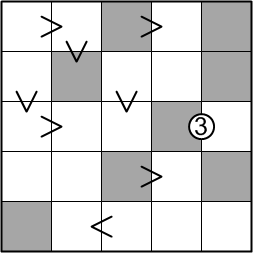 This is the example puzzle exactly as presented on the ænigma paper. We are given that we should place one of the digits 1 through 5 in each square of the grid such that (a) there is exactly one of each digit in each row and column, (b) squares that share a less-than or greater-than sign contain numbers that satisfy that inequality, and (c) squares that share a circled number contain digits that differ by exactly that amount.
This is the example puzzle exactly as presented on the ænigma paper. We are given that we should place one of the digits 1 through 5 in each square of the grid such that (a) there is exactly one of each digit in each row and column, (b) squares that share a less-than or greater-than sign contain numbers that satisfy that inequality, and (c) squares that share a circled number contain digits that differ by exactly that amount.
Are the rules quite clear, then? Jolly good! Let's get started!
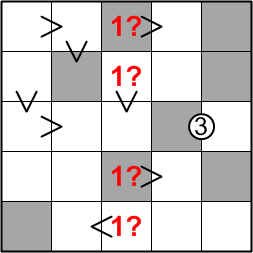 As in all of my ænigmas, the individual deductions involved in solving this puzzle will all be relatively straightforward; the difficulty lies in finding those deductions in the first place. One way to begin is by searching the grid for a single row or column where all, or almost all, of the squares are involved in some kind of a constraint; the hope is that only one square's constraints will allow some specific digit.
As in all of my ænigmas, the individual deductions involved in solving this puzzle will all be relatively straightforward; the difficulty lies in finding those deductions in the first place. One way to begin is by searching the grid for a single row or column where all, or almost all, of the squares are involved in some kind of a constraint; the hope is that only one square's constraints will allow some specific digit.
In this case, the central column looks promising: every single square there shares a less-than sign with some other square. As we examine it further, we notice that, indeed, almost every square is on the “greater” side of that sign. That suggests that we consider the digit most unlikely to satisfy such a constraint: the lowest digit in our repertoire, the 1.
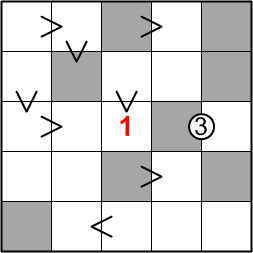 To satisfy all of the inequalities, the 1 can only be placed in one square in the middle column: the exact center of our grid.
To satisfy all of the inequalities, the 1 can only be placed in one square in the middle column: the exact center of our grid.
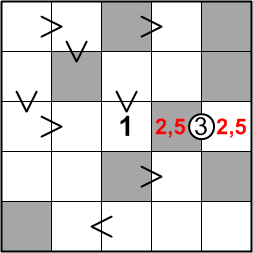 Now let us turn our attentions to the middle row of our grid. With the 1 in this row having been placed, there is only one pair of digits that could satisfy the circled-three constraint shared by the last two squares: those squares must contain a 2 and a 5, in one order or the other.
Now let us turn our attentions to the middle row of our grid. With the 1 in this row having been placed, there is only one pair of digits that could satisfy the circled-three constraint shared by the last two squares: those squares must contain a 2 and a 5, in one order or the other.
We cannot, at this stage, determine which square must contain which of these digits, so we make a little note to ourselves in both squares, listing the two possible digits for filling them. We will have to return to these squares later, once we possess sufficient information to resolve this ambiguity, but it's worth recording our insight nonetheless: perhaps even this partial information will prove helpful in making other deductions.
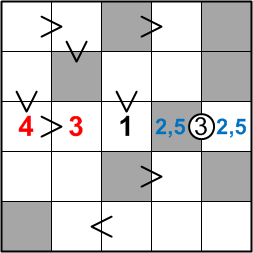 Staying in that central row, we now know, at least roughly, where the digits 1, 2, and 5 must be placed: they'll fill the rightmost three squares of the row. That leaves only the two digits 3 and 4 to occupy the other two squares in that row, and because those squares share a greater-than sign, we can immediately place them precisely.
Staying in that central row, we now know, at least roughly, where the digits 1, 2, and 5 must be placed: they'll fill the rightmost three squares of the row. That leaves only the two digits 3 and 4 to occupy the other two squares in that row, and because those squares share a greater-than sign, we can immediately place them precisely.
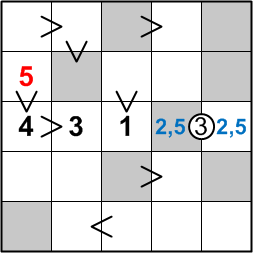 The 4 we've just placed is contrained to be less than the digit in the square above it. Since we are placing only the digits 1 through 5, there is but one way to satisfy that constraint: the upper square must contain a 5.
The 4 we've just placed is contrained to be less than the digit in the square above it. Since we are placing only the digits 1 through 5, there is but one way to satisfy that constraint: the upper square must contain a 5.
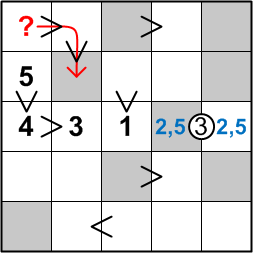 Consider the square in the upper-left corner of the grid. It begins a chain of three squares, as indicated by the red arrow, that are all linked by greater-than signs. That corner square's digit, therefore, must be strictly greater than at least two other digits in our repertoire. That is, it must be at least a 3.
Consider the square in the upper-left corner of the grid. It begins a chain of three squares, as indicated by the red arrow, that are all linked by greater-than signs. That corner square's digit, therefore, must be strictly greater than at least two other digits in our repertoire. That is, it must be at least a 3.
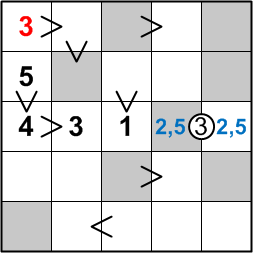 Since the leftmost column of the grid already contains a 4 and a 5, the only remaining digit that is at least a 3 is the digit 3 itself, and that is what must therefore be placed in the corner square.
Since the leftmost column of the grid already contains a 4 and a 5, the only remaining digit that is at least a 3 is the digit 3 itself, and that is what must therefore be placed in the corner square.
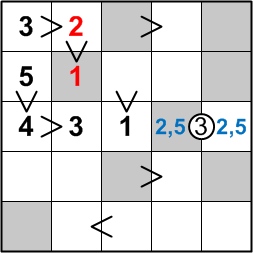 Of course, once that 3 has been placed at the head of a chain of three greater-than signs, there is only one way to fill in the remainder of that chain, with a 2 and a 1.
Of course, once that 3 has been placed at the head of a chain of three greater-than signs, there is only one way to fill in the remainder of that chain, with a 2 and a 1.
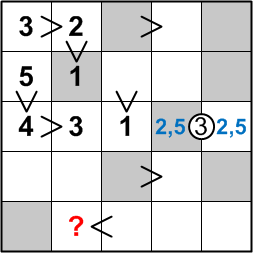 All but one of the squares in the second column of the grid are now either filled with digits or involved in some kind of constraint, so it has become a potentially fruitful place in which to search for our next deduction.
All but one of the squares in the second column of the grid are now either filled with digits or involved in some kind of constraint, so it has become a potentially fruitful place in which to search for our next deduction.
What digit could be placed in the bottom square of that column? It cannot be a 1, 2, or 3, since those digits have already been placed in that column, and yet it must still be less than the digit to its right.
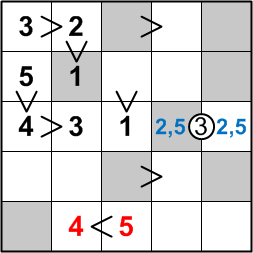 The only digit meeting these criteria, of course, is the 4, which implies that the digit to its right must be a 5.
The only digit meeting these criteria, of course, is the 4, which implies that the digit to its right must be a 5.
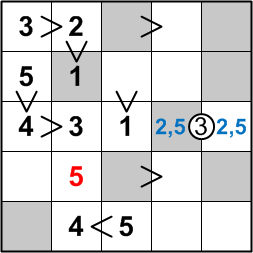 There remains only one square unfilled in the second column. The only digit left to place there is the 5.
There remains only one square unfilled in the second column. The only digit left to place there is the 5.
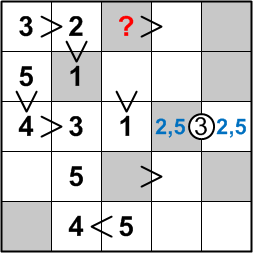 Let us now focus on the middle square in the top row of the grid. It cannot be a 2 or a 3, since its row already contains those digits, and it cannot be a 1 or a 5, since those digits have already been placed in its column.
Let us now focus on the middle square in the top row of the grid. It cannot be a 2 or a 3, since its row already contains those digits, and it cannot be a 1 or a 5, since those digits have already been placed in its column.
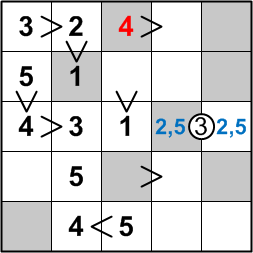 That leaves, of course, only the 4 to occupy that square.
That leaves, of course, only the 4 to occupy that square.
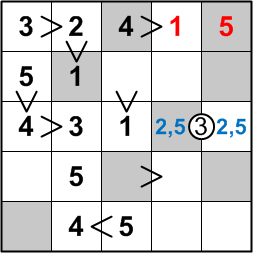 The square to the right of the 4 we just placed must contain a digit less than 4; since the 2 and 3 in that row are, as noted before, already in position, that square's digit clearly must be a 1. That leaves only the 5 to be placed in the final square in that row.
The square to the right of the 4 we just placed must contain a digit less than 4; since the 2 and 3 in that row are, as noted before, already in position, that square's digit clearly must be a 1. That leaves only the 5 to be placed in the final square in that row.
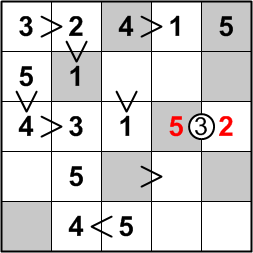 The 5 placed in the previous step has done us a great favor, finally resolving the 2/5 ambiguity we discovered early on in our efforts. The 5 in the middle row cannot be in the rightmost column now, since we've now already placed a 5 there, so it must be in the fourth column of that row, with the 2 in the final position.
The 5 placed in the previous step has done us a great favor, finally resolving the 2/5 ambiguity we discovered early on in our efforts. The 5 in the middle row cannot be in the rightmost column now, since we've now already placed a 5 there, so it must be in the fourth column of that row, with the 2 in the final position.
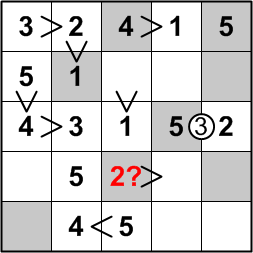 Returning our attentions to the central column of the grid, let us consider where that column's 2 could possibly be placed. Could it appear in the fourth row? That square is constrained to be greater than the square to its right. If we placed the 2 there, then the square to its right would have to be the 1. But that would leave us with two 1's in that column, a violation of the rules.
Returning our attentions to the central column of the grid, let us consider where that column's 2 could possibly be placed. Could it appear in the fourth row? That square is constrained to be greater than the square to its right. If we placed the 2 there, then the square to its right would have to be the 1. But that would leave us with two 1's in that column, a violation of the rules.
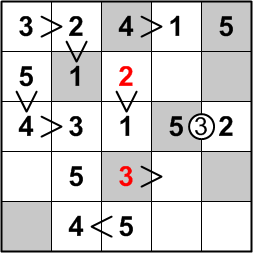 We can thus confidently place the middle column's 2 in the second row, leaving only the 3 to occupy that remaining fourth row.
We can thus confidently place the middle column's 2 in the second row, leaving only the 3 to occupy that remaining fourth row.
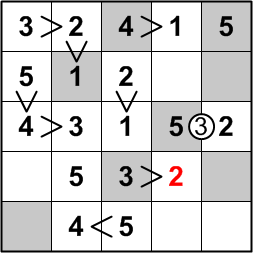 As noted earlier, the square we've just occupied with a 3 shares a greater-than sign with the square to its right. Since that neighboring square cannot contain a 1, we must place a 2 there.
As noted earlier, the square we've just occupied with a 3 shares a greater-than sign with the square to its right. Since that neighboring square cannot contain a 1, we must place a 2 there.
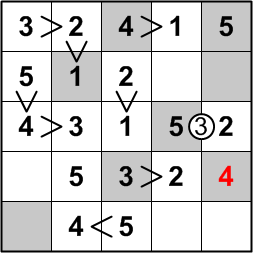 Gentle reader, we are now entering the final stages of our solution! Consider the fourth row of the grid: its 4 cannot be in the first column, since that column already contains a 4, so it must be placed in the final column.
Gentle reader, we are now entering the final stages of our solution! Consider the fourth row of the grid: its 4 cannot be in the first column, since that column already contains a 4, so it must be placed in the final column.
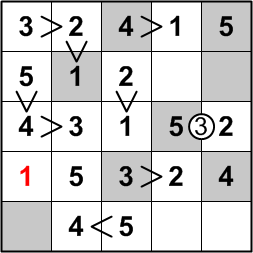 That, of course, leaves only the 1 to be placed in the first column of that fourth row.
That, of course, leaves only the 1 to be placed in the first column of that fourth row.
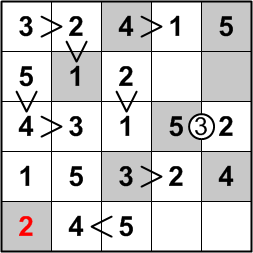 The first column now lacks only a 2.
The first column now lacks only a 2.
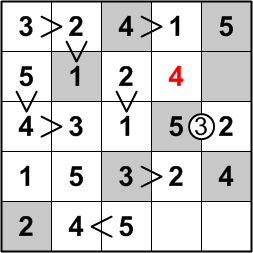 The second row as yet lacks a 4. It cannot be in the rightmost column, since that column already contains a 4, so it must be placed in the fourth column.
The second row as yet lacks a 4. It cannot be in the rightmost column, since that column already contains a 4, so it must be placed in the fourth column.
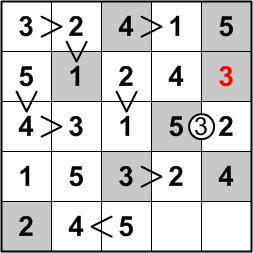 As is now familiar, we are forced to place the second row's missing 3 in the one remaining open position.
As is now familiar, we are forced to place the second row's missing 3 in the one remaining open position.
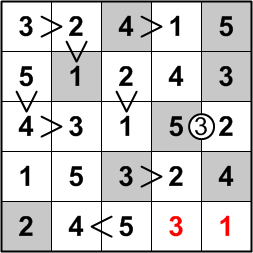 The fourth and fifth columns now each lack only one digit, both of which we can easily provide.
The fourth and fifth columns now each lack only one digit, both of which we can easily provide.
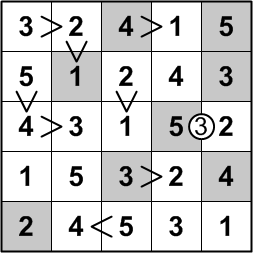 Here we pause for just a moment to savor our completed grid.
Here we pause for just a moment to savor our completed grid.
All that remains now is to discover this ænigma's final answer.
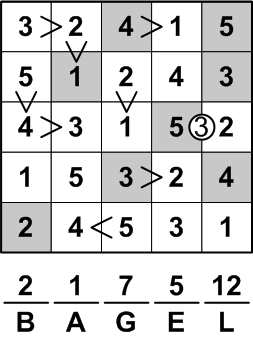 We are told to sum up the digits in each column that occupy shaded squares, and then to translate that sum into a letter using the traditional correspondence: 1 = A, 2 = B, and so forth. This is, of course, readily done, yielding one letter per column.
We are told to sum up the digits in each column that occupy shaded squares, and then to translate that sum into a letter using the traditional correspondence: 1 = A, 2 = B, and so forth. This is, of course, readily done, yielding one letter per column.
These letters, read in order, spell out the final answer to this ænigma: the word “BAGEL”.
Bravo, we've done it! Now return to your efforts on the original ænigma!
|
Shopping Cart |